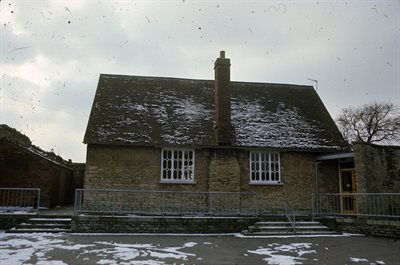Carlton School 1859 to 1871
This page was contributed by Pamela Hider

Carlton Old School 1970s (Courtesy of HER)
The Historic Environment Record for Bedfordshire describes the building as follows:
"Built in 1859. Small schoolroom of coursed rubble. 1 storey. Old clay tile roof, 2 fine casement windows with geometric glazing bars flanking central chimney stacks, stone to eaves level and brick above. Modern entrance porch to RH side".
1859-1871
The 1833 Education Returns (BHRS vol.67) tell us that there were three Sunday Schools in Carlton: two of the Established Church and the other of the dissenting congregation. Children from both Carlton & Chellington attended these schools. Our earliest reference to a Mixed Parochial School, taking children from both Carlton & Chellington, is in 1869 (Kelly's Directory) when Miss Beattie was Mistress. Later Kelly's directories (1898, 1910) tell us the school had been built in 1859 for 105 pupils. Before this, an Elizabeth Beattie had been Mistress of the Infants' School in Harrold 1853-54 so it is not unlikely that she came to Carlton to preside over the new bigger school. The census of 1871 tells us that she was still a school mistress and living in 'school cottage' at Bridgend, Carlton.
The First Education Act was passed in 1870 (more correctly it was known as the Elementary Education Act). It was a milestone in the provision of education in Britain demonstrating central government's unequivocal support for education of all classes across the country. It also sought to secularise education by allowing the creation of School Boards. These were groups of representatives, elected by the local ratepayers and the Board had the powers to raise funds to form a local rate to support local education, build and run schools, pay the fees of the poorest children, make local school attendance compulsory between the ages of 5 and 13 and could even support local church schools, though in practice they replaced them, turning them into Board run schools (known as Board Schools). The Act required a questionnaire of local schools in 1870. The return from Carlton read as follows: ‘Carlton (united with Chellington) Existing: School without the District, but available for it. Harrold Church of England School, places for 9 children. Required: Accommodation for 100 children in the village of Carlton. If Carlton and Chellington National Church of England School be at once made efficient by a supply of school furniture, and by the appointment of a certified teacher, no further accommodation will be required' (ibid). Vestry Minutes of 1872 recorded 'Financial support for schools'; and also recorded a meeting of the School Committee dated 15/11/1872 which ratified the "form of agreement between the School Committee & Schoolmaster and the resolution that children of labourers should be charged 1d a week for attendance at day school" (P92/8/1). (School fees were abolished in the 1891 Elementary Education Act).